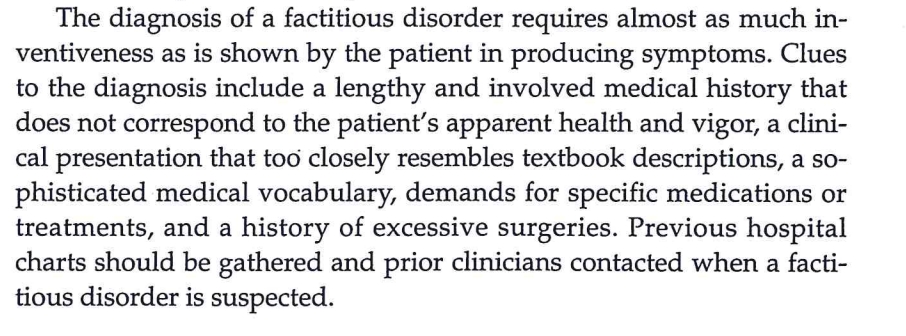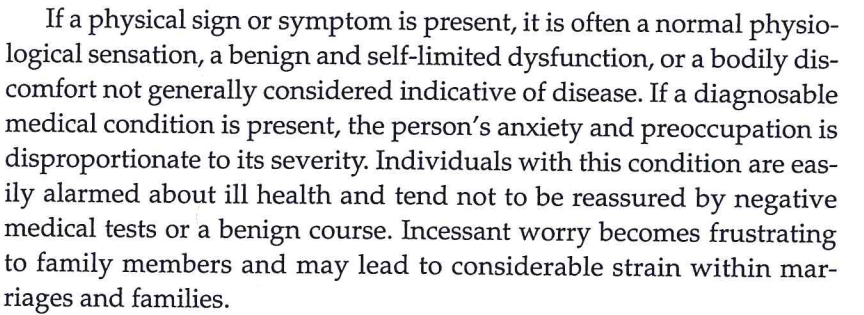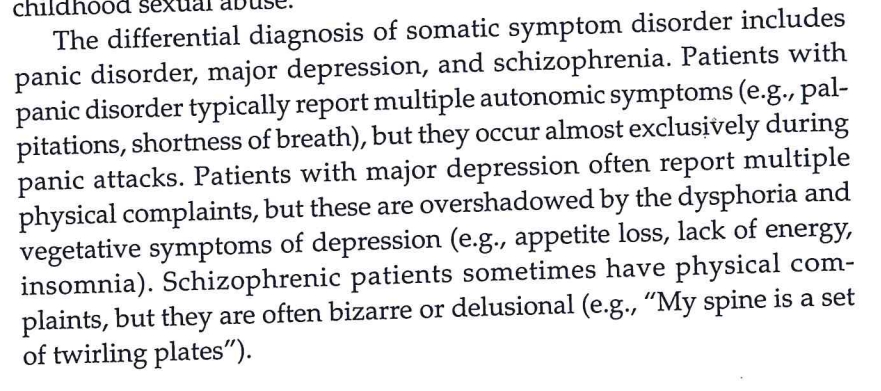Factitious Disorders
Factitious
Both factitious disorder and malingering involve the conscious production of symptoms.
However, factitious disorder is primarily rewarded by primary gain (being sick), while malingering is rewarded by secondary gain (money).
Factitious disorder (Munchausen syndrome) is the simulation of physical or psychiatric illness to receive attention from medical personnel. It is manifested by a chronic history of multiple hospital admissions and willingness to receive invasive procedures.
pretend to have illness but doesn't
produce symptoms of illness (inject feces to have infection, take warfarin to produce bleeding disorder)
Patients with factitious disorder are not seeking any external rewards, but simply want to assume the sick role (primary gain).
There is a higher incidence in health care workers who know how to simulate signs of real illness.
Factitious disorder by proxy is the simulation of illness in another person, such as a parents feigning their child's illness. This is a form of child abuse, and must be reported.
Diagnosis

Malingering
Malingering is the conscious simulation of physical illness for financial or other obvious gain (e.g. avoiding work, obtaining drugs). It is not a psychiatric pathology.
A malingering patient will generally refuse a good prognosis. Their complaints and symptoms may cease after their desired objective is attained.


Physiological Gain
Psychological gain is a psychological reward mechanism. In the context of psychiatric medicine, psychological gain has importance in understanding somatic and factitious disorders. It is very important to note that primary, secondary, and tertiary gains can be either conscious or subconscious!
Primary gain is what the symptom does for the patient’s internal psychic economy (e.g. gain of psychological support/attention from others, self-justification).
Example: A patient gains sympathy and attention for their medical problem.
Secondary gain is what the symptom gets the patient (e.g. money, avoidance of legal penalties). Note that the gains motivating malingering are primarily secondary.
Example: A child feigns a cold to get out of school.
Tertiary gain is what a third party (e.g. caretaker, family member) gains from a patient's illness.
Example: A physician is rewarded with the intellectual pursuit of an interesting case.
Somatic Symptoms
Somatic symptom disorder and related disorders (illness anxiety, conversion disorder) are subconsciously driven, such that patients truly believe they have a health problem.
Symptom production in somatic symptom disorder and related disorders (illness anxiety, conversion disorder) may either produce primary or secondary psychological gain.
Somatic symptom disorder is characterized by at least one somatic symptom (including pain) with associated excessive thoughts or behavior related to the symptom (anxiety, exaggerated fear, excessive behavioral changes). Symptoms must occur for >6 months.
Somatic symptom disorder is a new diagnosis in DSM-V, replacing somatization disorder and pain disorder. The diagnostic criteria of somatization disorder (4 pain symptoms, 2 GI symptoms, etc.) no longer apply.
Somatic symptom disorder is similar to illness anxiety disorder in that both patients experience significant anxiety about their health. Somatic symptoms disorder is distinguished by a presence of somatic symptoms.
In contrast, patients with illness anxiety disorder fear having a specific illness but have minimal or no physical symptoms; they are primarily concerned with the idea that they have an illness.
Illnexx anxiety:


Symptoms are typically more prominent during periods of psychological stress. Optimal management includes regularly scheduled visits with a single provider to develop the physician-patient relationship and monitor the condition, while avoiding unnecessary diagnostic testing and specialist referrals. The physician should focus on discussing the role of psychosocial stressors on somatic symptoms and promoting stress reduction and healthy behaviors (eg, sleep hygiene, relaxation techniques, exercise, diet, return to productive activities).
Providing reassurance or repeated explanations is minimally effective as these patients are rarely reassured by negative findings.


Illness Anxiety
Illness anxiety disorder (formerly hypochondriasis) is characterized by exaggerated concern with health and illness, while symptoms and actual disease are minimal or absent.
Patients with illness anxiety disorder remain concerned/anxious despite evidence to the contrary; reassurance and explanation are ineffective.
Illness anxiety disorder is episodic, and exacerbations typically occur under stress. The most effective step in resolving an episode of illness anxiety disorder is resolution of the psychological stressor. Treatment can also include psychotherapy and pharmacotherapy for symptomatic relief.
Conversion
Conversion disorder is characterized by at least one neurological (motor or sensory) symptom, typically preceded by a psychological stressor (bereavement, significant life event, etc.). Common examples of symptoms include shifting paralysis, blind/deaf/mute, paresthesias, and pseudoseizure.
"La belle indifference" is characteristic, but not diagnostic, of conversion disorder. Patients have sudden appearance of symptoms, but appear relatively unconcerned.
Most patients spontaneously recover from conversion disorder.
The first-line treatment of conversion disorder is education and reassurance that symptoms will improve over time.
Pseudoseizure
"Pseudoseizures" are seizure-like convulsions of patients with conversion disorder. Normal prolactin levels (prolactin may be elevated after seizures) or normal EEG findings supports, but does not confirm a pseudoseizure.
Pseudocyesis
A disorder in which the patient believes that they are pregnant when in reality they are not., Aka “false pregnancy.”
Last updated
Was this helpful?